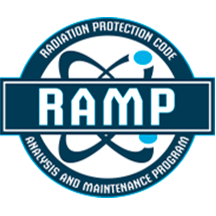Let’s put it in context! Are you wondering how other users are using RAMP codes? Welcome to the university corner library which has collections of peer reviewed references which you can look up to get more information on RAMP codes. If you have published a paper which included use or information on a RAMP code that you would like included in the library, please use the “Contact Us” button to tell us about your publication. If you are looking for manuals on code use, navigate to the codes page of this website and find manuals and guides for use under the documentation section.
V+
- Sharpe, K., McCallum, S., O’Neill, J., Paterson, C., McCormick, J., & Sexton, K. (2024). Occupational skin dose from radionuclide contamination: one country’s approach at standardising skin dose estimates using Varskin+. Journal of Radiological Protection, 44(2), 022501. https://doi.org/10.1088/1361-6498/ad35ce
- Anspach, L. J, and D. M Hamby. “PERFORMANCE OF THE VARSKIN 5 (v5.3) ELECTRON DOSIMETRY MODEL.” Radiation protection dosimetry 181.2 (2018): 111–119. Web. DOI: 10.1093/rpd/ncx302
- Dubeau, J et al. “A COMPARISON OF BETA SKIN DOSES CALCULATED WITH VARSKIN 5.35.3 AND MCNP5.” Radiation protection dosimetry 182.4 (2018): 502–507. Web. DOI: 10.1093/rpd/ncy108
- Sherbini, Sami et al. “Validation of the Photon Dose Calculation Model in the VARSKIN 4 Skin Dose Computer Code.” Health physics (1958) 103.6 (2012): 763–769. Web. DOI: 10.1097/HP.0b013e31825fefb8
- Tchouaso, Modeste Tchakoua, and William H Miller. “Beta Skin Dosimetry Using Passivated Planar Silicon Detector.” Applied radiation and isotopes 135 (2018): 99–103. Web. DOI: 10.1016/j.apradiso.2018.01.026
- Yoo, Jaeryong, and Young Woo Jin. “Establishment of Criteria for Skin Decontamination in a Radiation Emergency.” Health physics (1958) 115.3 (2018): 369–374. Web. DOI: 10.1097/HP.0000000000000891
- Mangini, Colby D, and David M Hamby. “SCALING PARAMETERS FOR HOT-PARTICLE BETA DOSIMETRY.” Radiation protection dosimetry 172.4 (2016): 356–366. Web. DOI: 10.1093/rpd/ncv529
RADTRAD
- Lin, Y.P. and Y.R. Yuann, Reanalysis of environmental qualification radiation parameters for Kuosheng nuclear power plant. Kerntechnik, 2019. 84(1): p. 54-58.
- Hsu, W.S., et al., Evaluation of control room habitability in case of LOCA for Maanshan NPP using codes RADTRAD, HABIT and ALOHA. Kerntechnik, 2018. 83(1): p. 63-71.
- Jimenez, G., et al., Analysis of the operator action and the single failure criteria in a SGTR sequence using best estimate assumptions with TRACE 5.0. Annals of Nuclear Energy, 2013. 58: p. 161-177. DOI: 10.1016/j.anucene.2013.02.023
- Mancini, F.C.V., E. Gallego, and M.E. Ricotti, Revising the Emergency Management Requirements for new generation reactors. Progress in Nuclear Energy, 2014. 71: p. 160-171. DOI: 10.1016/j.pnucene.2013.12.002
- Rebollo, M.J., et al., Evaluation of the offsite dose contribution to the global risk in a Steam Generator Tube Rupture scenario. Reliability Engineering & System Safety, 2016. 147: p. 32-48. DOI: 10.1016/j.ress.2015.10.016
RASCAL
- Kyne, D. Nuclear Power Plant Emergencies in the USA: Managing Risks, Demographics and Response. Springer International Publishing. 2017. ISBN: 3-319-50343-X.
- Lee, J.H., Yilmaz, A., Denning, R., Aldermira, T., Use of Dynamic Event Trees and deep Learning for Real-Time Emergency Planning in Power Plant Operation. Nuclear Technology, 2019. 205: P:1035-1042.
- Rossi, F., Guglielmelli, A., Rocchi, R., Impact of a Security Event at a TRIGA Reactor. Nuclear Energy Journal, 2014. DOI: 10.1016/j.anucene.2014.09.030
- Abbott, Michael L. “Comparison of U.S. NRC’S Rascal Emergency Response Code with NOAA’s HYRAD Dispersion Model and Tracer Experimental Data.” Health physics (1958) 115.4 (2018): 448–457. Web. DOI: 10.1097/HP.0000000000000907
- Hamed, Abdelfatah A, E. F Salem, and Asmaa K Abdien. “Estimation of Radiation Doses for Transition from Emergency to Existing Exposure Situation.” Nukleonika 60.4 (2015): 943–950. Web. DOI: 10.1515/nuka-2015-0146
ARCON
- Jeong, H., et al., Analysis of atmospheric dispersion factors for building wakes at the Wolsung nuclear site in Korea. Radiation Protection Dosimetry, 2013. 154(4): p. 430-8. DOI: 10.1093/rpd/ncs272.
- Liu, Y., et al., Enhanced air dispersion modelling at a typical Chinese nuclear power plant site: Coupling RIMPUFF with two advanced diagnostic wind models. Journal of Environmental Radioactivity, 2017. 175-176: p. 94-104. DOI: 10.1016/j.jenvrad.2017.04.016
- Li, X., et al., Radiological habitability evaluation of the control room of the high-temperature reactor pebble-bed module: post-accident dose assessment and sensitivity studies. Journal of Nuclear Science and Technology, 2018. 55(11): p. 1263-1274. DOI: 10.1080/00223131.2018.1492982
DandD
- Agency, I.A.E., Innovative and Adaptive Technologies in Decommissioning of Nuclear Facilities. 2008, Vienna: International Atomic Energy Agency.
- Seo, Hyung-Woo, Jae Yong Oh, and Weon Gyu Shin. “Proposal for the List of Potential Radionuclides of Interest During NPP Site Characterization or Final Status Surveys.” Nuclear engineering and technology. 53.1 (2021): 234–243. Web. DOI: 10.1016/j.net.2020.06.007
GALE
- Chandrasekaran, T., J. Y. Lee, and C. A. Willis. Calculation of Releases of Radioactive Materials in Gaseous and Liquid Effluents from Pressurized Water Reactors : PWR-GALE Code. Washington, D.C.: Division of Systems Integration, Office of Nuclear Reactor Regulation, U.S. Nuclear Regulatory Commission, 1985. Print.
GENII
- Kwon, Ki Nam, Cheong, Jae Hak, Development of a reference framework to assess stylized human intrusion scenarios using GENII Version 2 considering design features of planned near-surface disposal facility in Korea. Nuclear Engineering and Technology, 2019-09-01, Vol 51 (6), p. 1561-1574. DOI: 10.1016/j.net.2019.04.019
- Teodori, F. “The Latest Development and the New Extended Capabilities of the GENII-LIN Soil Transfer Model.” Radiation physics and chemistry (Oxford, England : 1993) 174 (2020): 108949–. Web. DOI: 10.1016/j.radphyschem.2020.108949
- Mohammed Saeed, Ismael Mohammed et al. “Atmospheric Dispersion Modeling and Radiological Safety Assessment for Expected Operation of Baiji Nuclear Power Plant Potential Site.” Annals of nuclear energy 127 (2019): 156–164. Web. DOI: 10.1016/j.anucene.2018.11.045
- Kim, Minseong, Sung-Wook Hong, and Jin Beak Park. “Uncertainty Management on Human Intrusion Scenario Assessment of the Near Surface Disposal Facility for Low and Intermediate-Level Radioactive Waste: Comparative Analysis of RESRAD and GENII.” Journal of the Nuclear Fuel Cycle and Waste Technology(JNFCWT) 15.4 (2017): 369–380. Web. DOI: 10.7733/jnfcwt.2017.15.4.369
- Amr Abdelhady. “Radiological Effect of Cask-Drop Accident in Open-Pool Spent Fuel Storage.” Radiation protection and environment 41.4 (2018): 197–202. Web. DOI: 10.4103/rpe.RPE_67_18
- Rossi, F, A Guglielmelli, and F Rocchi. “Impact of a Security Event at a TRIGA Reactor.” Annals of nuclear energy 76 (2015): 125–136. Web. DOI: 10.1016/j.anucene.2014.09.030
HABIT
- Hsu, W.S., et al., Evaluation of control room habitability in case of LOCA for Maanshan NPP using codes RADTRAD, HABIT and ALOHA. Kerntechnik, 2018. 83(1): p. 63-71.
MILDOS
- LePoire, D.J., et al., MILDOS uranium milling dose assessment code update. Health Physics, 2001. 81(5 Suppl): p. S78-84.
- Skinner, D.J., A comparison of RA-226 deposition predictions obtained from MILDOS-ANL computer code to soil concentrations measured downwind from a uranium mill tailings complex. Health Physics, 1983. 45(1): p. 222-222.
NRCDose (NRCDose, GASPAR, LADTAP, XOQDOQ)
- Harris, J.T., Miller, D.W., Radiological Effluents Released by U.S. Commercial Nuclear Power Plants From 1995-2005. Health Physics, 2008. 95 (6): p 734-743. DOI: 10.1097/01.HP.0000324201.89669.30
- Simpkins, A.A., Hamby, D.M., Predicted Versus Measured Tritium Oxide Concentrations at the Savannah River Site. Health Physics, 1997. 72 (2): p 179-185.
- Hamby, D.M., Simpkins, A.A., Three-Parameter Model for Estimating Atmospheric Tritium Dose At the Savannah River Site. Health Physics, 1998. 75(3): p 269-277.
- Vold, E., Ingestion Pathway Factor in Dose Assessment for Annual Airborne Releases of Radioactivity. Health Physics, 1984. 47(3): p:429-441.
- Endo, A., Henshaw, J., Mignanelli, M.A., Time-Dependent Chemical Compositions of 13n and 15O Induced in Air by the Operation of a High Energy Electron Accelerator. Health Physics, 1998. 74(4): p. 456-464.
- Carlton, W.H. Murphy, C.E., Evans, A.G., Radiocesium in the Savannah River Site Environment. Health Physics, 1994. 67(3): p. 233-244.
- Carlton, W.H., Murphey, C.E., Evans, A.G., Plutonium in the Savannah River Site Environment. Health Physics, 1996. 71(3): p.290-299.
- Hamby, D.M., A Probabilistic Estimation of Atmospheric Tritium Dose. Health Physics, 1993. 65(1): p.33-40.
- Somlai, J., Horvath, M., Kanyar, B., Lendvai, Z., Nemeth, C.S., Radiation Hazard of Coal-Slags as Building Material in Tatabanya Town (Hungary). Health Physics, 1998. 75(6): p648-651. DOI: 10.1016/S0140-6701(99)91357-7
- Ribela, M.T.C.P., Marone, M.M.S., Bartolini, Use of Radioiodine Urinalysis for Effective Thyroid Blocking the First Few Hours Post Exposure. Health Physics, 1999. 76(1): p.11-16.
- Hamby, D.M., Site Specific Parameter Values for the Nuclear Regulatory Commission’s Food Pathway Dose Model. Health Physics, 1992. 62(2): p 136-143.
- Hamby, D.M., A Methodology for Estimating the Radiological Consequence of an Acute Aqueous Release. Health Physics, 1992. 62(6): p. 567-570.
- Rong, X. Kutikkad, K., Langhorst, S.M., A Comparison of Results for the University of Missouri Research Reactor Radiological Airborne Release Assessments Obtained from PC-Based Computer Programs. Health Physics, 1995. 68(6): p.845-850.
- Simpkins, A.A., Hamby, D.M., Predicted Versus Measured Tritium Oxide Concentrations at the Savannah River Site. Health Physics, 1997. 72(2): p. 179-185.
- Marter, W.L., Comments on ‘Analysis of External Gamma Radiation Data Around the Savannah River Plant’. Health Physics, 1986. 50(5): p.652-655.
- Hamby, D.M., A Probabilistic Estimation of Atmospheric Tritium Dose. Health Physics, 1993. 65(1): p. 33-40.
- Lahti, G.P., Hubner, R.S., Golden, J.C., Assessment of Gamma-Ray Exposures Due to Finite Plumes. Health Physics, 1981. 41(2): p.319-340.
PIMAL
- Griffin, K.T. and M.B. Bellamy, Validation of PIMAL 3.0-Phantom with Moving Arms and Legs. Radiation Protection Dosimetry, 2017. 174(1): p. 62-67. DOI: 10.1093/rpd/ncw097
- Dewji, S., et al., Estimated dose rates to members of the public from external exposure to patients with 131I thyroid treatment. Medical Physics, 2015. 42(4): p. 1851-7. DOI: 10.1097/HP.0000000000000327
- Dewji, S., K.L. Reed, and M. Hiller, Comparison of photon organ and effective dose coefficients for PIMAL stylized phantom in bent positions in standard irradiation geometries. Radiation and Environmental Biophysics, 2017. 56(3): p. 277-291. DOI: 10.1007/s00411-017-0698-1
- Bales, K., S. Dewji, and E. Sanchez, Comparison of neutron organ and effective dose coefficients for PIMAL stylized phantom in bent postures in standard irradiation geometries. Radiation and Environmental Biophysics, 2018. 57(4): p. 375-393. DOI: 10.1007/s00411-018-0751-8
- Dewji, S.A., et al., Assessment of the Point-Source Method for Estimating Dose Rates to Members of the Public from Exposure to Patients with 131I Thyroid Treatment. Health Physics, 2015. 109(3): p. 233-41. DOI: 10.1097/HP.0000000000000327
Turbo FRMAC
- Updates to Protective Action Guides Manual: Protective Action Guides (PAGs) and Planning Guidance for Radiological Incidents. Vol. 78. Washington: Federal Information & News Dispatch, LLC, 2013. Print. ISSN: 0097-6326

